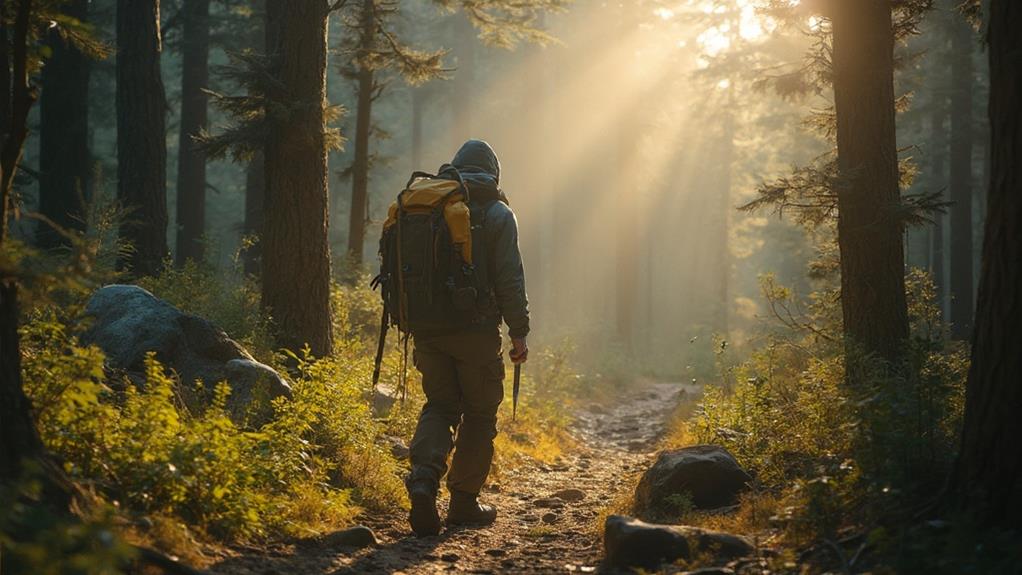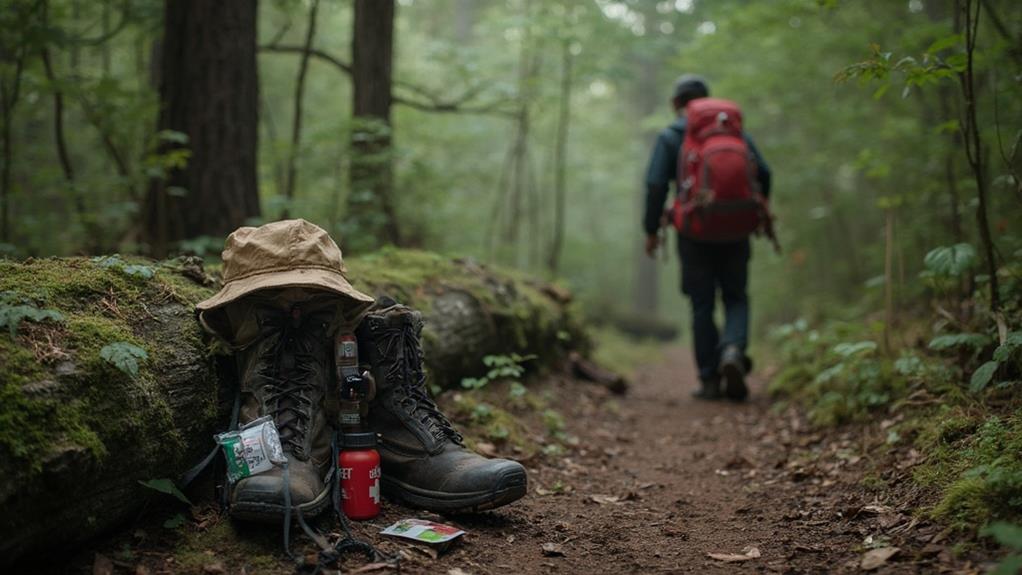Solo hiking can be safe and enriching for beginners when approached with care. It offers numerous benefits, including enhanced mental health and personal growth. Beginners should start with short, familiar trails and conduct thorough trail research. Essential preparations include carrying first aid supplies, navigation tools, and notifying someone about the planned route. Proper clothing and sufficient water are essential for safety and comfort. Gaining basic navigation skills and honing decision-making abilities are also important. While solo hiking can be intimidating, with the right strategies, fears can be transformed into confidence. Discover more tips to guarantee a rewarding solo hiking experience.
Key Takeaways
- Beginners should start with short, familiar trails to build confidence and skills.
- Inform someone about your hiking plan and expected return time for safety.
- Equip with essential safety gear, including a charged phone and navigation tools.
- Carry a well-stocked first aid kit and know basic first aid procedures.
- Educate yourself on wildlife behavior and carry deterrents like bear spray.
Benefits of Solo Hiking
Starting on a solo hiking adventure offers a multitude of benefits that extend beyond the obvious physical exercise. One of the most significant advantages is the potential for enhanced mental health. The solitude of solo hiking allows individuals to escape daily distractions, fostering mindfulness and offering a serene environment for deep reflection. This meditative experience can lead to reduced stress levels and improved emotional well-being.
Moreover, solo hiking is a catalyst for personal growth. It empowers individuals to exercise autonomy in choosing routes and setting their own pace, which enhances self-reliance and decision-making skills. This freedom allows one to fully engage with the natural surroundings, promoting a sense of accomplishment as solo hikers navigate and solve challenges independently. The journey itself becomes a demonstration of personal resilience and confidence.
Additionally, the flexibility inherent in solo hiking provides a personalized experience. Hikers can pause to capture the perfect photograph or explore areas of interest at their leisure, without the need to coordinate with others.
This self-driven exploration not only leads to a greater sense of fulfillment but also reinforces a profound connection with nature, further enriching the hiking experience.
Preparing for Your First Solo Hike

Setting out on your first solo hike requires careful preparation to guarantee a safe and enjoyable experience. The cornerstone of your preparation should be thorough trail research. Start by selecting a suitable hiking route that matches your fitness level and experience. Investigate the trail’s length, difficulty, and current weather conditions, as these factors are vital for planning appropriately.
Begin with short, familiar trails to build your confidence and skills before progressing to more challenging hikes.
Creating a detailed hiking plan is essential. It should outline your chosen route, estimated return time, and emergency contact information. This plan must be shared with a trusted friend or family member, ensuring someone is aware of your whereabouts should you require assistance.
Equipping yourself with essential gear is another important aspect of preparation. Always carry a first aid kit, navigation tools such as a map and compass, sufficient water, and appropriate clothing to adapt to changing weather conditions.
Lastly, invest time in learning basic first aid and emergency procedures. Consider enrolling in a wilderness first aid course to better prepare for unexpected situations.
Safety Tips for Beginners
Starting on a solo hiking adventure requires a strong focus on safety protocols to guarantee a secure and enjoyable experience. One of the foremost steps in emergency preparedness is informing a trusted friend or family member about your hiking itinerary, including your route and expected return time. This assures that someone is aware of your location and can alert authorities if necessary.
Equipping yourself with essential safety gear is non-negotiable. A charged phone loaded with reliable navigation apps, coupled with a power bank, guarantees you can call for assistance. Additionally, carrying a thorough first aid kit is critical. Familiarity with basic first aid procedures will empower you to manage potential injuries encountered on the trail.
Developing solid navigation skills is indispensable for solo hikers. While GPS devices are incredibly useful, they are not infallible. Learning to read maps and use a compass is fundamental, particularly in remote areas where technology may falter due to poor service.
Begin your solo hiking journey with short, familiar trails, progressively tackling more challenging routes as your confidence and experience grow. Understanding your physical and mental limits is paramount to a safe and rewarding solo hiking venture.
Essential Gear Checklist

Setting out on a solo hiking journey necessitates careful preparation, and an essential gear checklist is imperative to guarantee safety and comfort. For beginners, understanding the significance of essential gear and effective packing strategies can mean the difference between a rewarding adventure and a challenging ordeal.
A well-stocked first aid kit is indispensable; it should contain adhesive bandages, antiseptic wipes, gauze, and pain relievers, making sure you’re prepared for minor injuries.
Navigation tools are another priority. A paper map, compass, or GPS device can prevent disorientation, but it’s essential to practice using them beforehand.
Regarding packing strategies, verify these items are easily accessible. Adequate hydration is critical for any hike; carry a hydration pack or water bottles with at least a two-liter capacity for day hikes.
Equally important is quality clothing. Moisture-wicking base layers, a waterproof jacket, and sturdy hiking boots enhance both comfort and safety.
Don’t overlook the Ten Essentials, which include food, water, navigation tools, first aid supplies, and emergency shelter. Integrating these into your packing checklist will guarantee that you are well-prepared for the challenges of solo hiking, fostering both confidence and security on your journey.
Overcoming Common Fears
For many beginners, starting on a solo hiking adventure can be intimidating due to common fears such as wildlife encounters, getting lost, or facing unpredictable weather. Understanding these fears and learning how to manage them can transform apprehension into confidence.
Wildlife encounters often top the list of concerns for novice hikers. However, by educating oneself on animal behavior and carrying deterrents like bear spray, anxiety can be greatly reduced, ensuring a safer experience. Equipping oneself with appropriate knowledge and tools empowers hikers to appreciate wildlife without fear.
Navigational uncertainties pose another challenge. To mitigate the fear of getting lost, beginners should invest time in honing their navigation skills. Utilizing GPS devices and offline maps, along with practicing these skills on familiar trails, can considerably enhance a hiker’s ability to navigate unfamiliar terrain confidently.
Unpredictable weather is another common worry. By dressing in layers, checking weather forecasts, and carrying waterproof gear, hikers can be better prepared to face sudden weather changes, allowing them to focus on the adventure rather than potential discomfort.
Frequently Asked Questions
How Safe Is Solo Hiking?
Solo hiking can be safe if one follows essential safety tips and engages in thorough solo preparation. This includes researching trails, checking weather conditions, carrying necessary gear, and informing others of your plans to verify a secure experience.
Is It Safe to Hike on My Own?
Hiking alone can be safe if proper precautions are taken. Equip yourself with appropriate hiking gear and adhere to safety tips, such as planning the route, checking weather conditions, and informing someone of your itinerary and return time.
Is It Awkward to Hike Alone?
Hiking alone can initially feel awkward; however, it offers numerous benefits. Solo hiking encourages personal reflection, allowing individuals to embrace solitude, appreciate nature’s beauty, and ultimately cultivate independence and self-reliance, transforming initial discomfort into a fulfilling experience.
How Far Can a Beginner Hike?
A beginner’s hiking distance should ideally range from 3 to 5 miles on well-marked, flat trails. Beginner tips include starting with shorter hikes, considering elevation gain, and maintaining a manageable pace to guarantee a safe experience.
Conclusion
Solo hiking offers numerous benefits, including self-discovery, increased confidence, and a deeper connection with nature. Adequate preparation is essential for ensuring a safe and enjoyable experience. Beginners are advised to prioritize safety by researching trails, informing others of plans, and carrying essential gear such as maps, first-aid kits, and navigation tools. Overcoming common fears involves building experience gradually and learning from each hike. Ultimately, with proper preparation and awareness, solo hiking can be a rewarding endeavor for beginners.